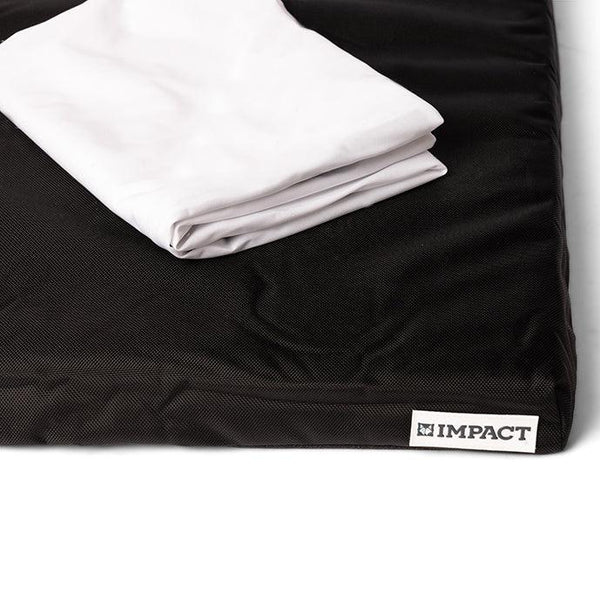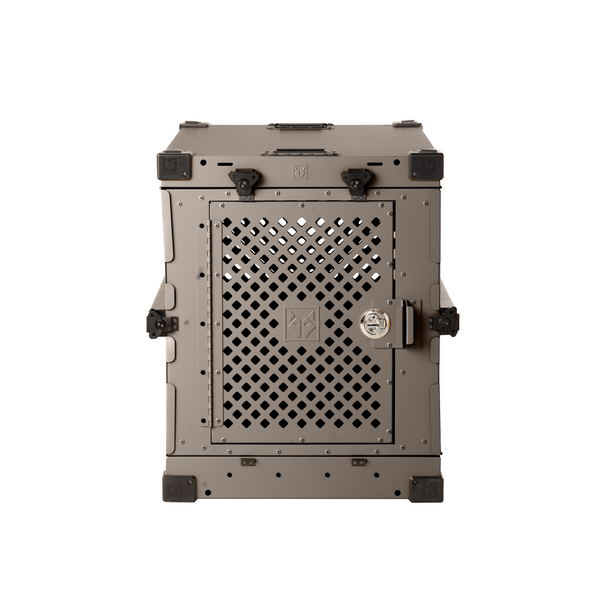As dog owners know, crate training is a crucial part of pet ownership. Dog crates are one of the best training tools for your pups, providing a safe and secure space for your four-legged friend to relax. Not only that, but dog crates encourage positive behavior, teach housetraining, and soothe anxiety in dogs. Keep reading for our 5 tips for crate training your pup.
Benefits of Crate Training
- Crates Provide a Comforting Space for Your Dog
- Airplane and Vehicle Travel is Safer with a Crate
- Crates Keep your Dogs Safe During Emergencies
- Crates are a Powerful Tool for House Training
- Crates Protect Your Pup and Home
Want to learn more about why you should crate train your dog? Check out this blog post on 5 Reasons to Crate Train Your Dog.
How to Crate Train Your Dog: 5 Steps
1. Take Time Introducing Your Dog to Their Crate
Introducing your dog to their crate is a process that shouldn’t be rushed. After all, a new crate- especially if your dog has never seen one before, can be quite intimidating for any dog. Try looking at things from your dog’s perspective, as they’re probably thinking “what is this large metal box in my living room?” So yeah, a crate can be pretty scary for a dog at first. Therefore, crate training is not going to happen overnight, and that’s something dog owners should be aware of before embarking on this journey.
Introducing your dog to their crate can take anywhere from a few days to a few weeks. After all, every dog is different and is going to move at their own pace. To introduce your dog to their crate, start by finding the best location in your home for the crate. Ideally, a crate should be placed in an area with little-to-no noise or foot traffic. The reason for this is that the crate being in a loud or busy section of the house can contribute to your dog feeling frustrated or anxious being in their crate. Think of it this way; it wouldn’t be too great seeing everyone around you having a fun time but you can’t join in. Now, imagine how your dog would feel if they were expected to hang out inside of their crate while there are tons of fun and exciting things going on outside of the crate. Thus, crate location matters.
After finding the ideal spot for the crate, it’s time to start the introductions. First, allow your dog to familiarize themselves with the crate, such as by sniffing it. Before even considering putting them inside the crate, they must not be scared to approach the crate. Next up is allowing your dog to freely move in and out of the crate. While supervising, leave the door to the crate open and allow your dog to explore. Do not close the door to the crate, as they must first be comfortable with the crate before you shut the door. They may very well be hesitant at first to go inside, which is totally okay. Only after your dog feels comfortable exploring the open crate should you shut the door. Being locked inside of a crate may be scary at first with your pup, which is why it's important that you make sure your four-legged friend doesn’t view the crate as a “bad” place. With proper training, your dog will come to recognize the crate as a positive, relaxing space just for them.
2. Prep the Crate for Your Pup
A crate is much warmer and more inviting for your dog when it's comfortable. Thus, make sure to prepare the crate for your dog. It's generally recommended that dogs have a crate pad inside of their crate, as this provides a soft and cozy floor for your dog to lay on. When finding the right pad for your crate, it's important that it is fitted. If the pad is too small for the crate, there will be lots of opportunities for your dogs to move around or chew up the pad.
When it comes to choosing the right crate pad for your pup, it shouldn’t be a “one size fits all” approach. After all, every dog has unique needs. For dogs with sensitive joints that may need extra support, consider an Orthopedic Crate Pad for your crate. Unlike your standard vinyl crate pad, an Orthopedic Crate Pad contains a thick foam cushion designed to offer the maximum amount of muscle support for your pup.
After finding the perfect pad for your crate, consider what items- if any, to put inside of the crate. A chew toy or treat can be a great trick for helping your dog feel more comfortable inside of their crate. Plus, if your dog doesn’t want to sleep right away, a toy for them to chew on can give them something to do to occupy themselves. To help your dog with the adjustment process, consider placing some of their other favorite items inside the crate. A common trick utilized by dog owners is to take an item that smells like them, such as a worn shirt, and place it inside the crate. Numerous studies have shown that dogs are easily comforted by their owners' scent, so this is an easy hack to make the crate a more comforting space for your pup.
3. Use Positive Reinforcement
Out of the many training methods commonly utilized with dogs, positive reinforcement is one of the most effective methods for crate training your pups. Positive reinforcement is a reward-based training approach that emphasizes creating the association of positive feelings with actions. When applied to crate training, positive reinforcement aims to make the crate a happy space for your pup. When done correctly, positive reinforcement will have your dog looking forward to and enjoying their time in their crate.
So how can positive reinforcement be used for crate training? It’s quite simple; dog owners should make their dogs feel rewarded anytime they get in their crate. We all know our dogs best, so different rewards may work for different dogs. If your dog responds well to praise, consider praising them every time they go into their crate. Similarly, if your dog will do anything for treats, use your pup’s favorite treats as a reward.
Pretty soon, your dog will begin associating the behavior of going into their crate with the reward; praise. When they expect this positive outcome, dogs are more willing to pursue the behavior that prompts this reward. In other words, positive reinforcement teaches dogs to become more comfortable with their crate through the use of rewards.
To succeed in using positive reinforcement to crate-train your dog, repetition is absolutely crucial. Make it a habit to repeat giving commands and providing rewards for your pups to create a positive association. Repetition is what will help your dog learn this behavior, but remember to be patient too; as positive reinforcement is not going to work instantaneously. With practice, your dog will begin associating their crate with positive feelings in no time.
4. Give Them Some Alone Time
Now, this is the step where positive reinforcement comes into play again. Once your dog has been fully introduced to their crate and their crate has been prepared, you can begin practicing leaving them alone for some time in the crate. As expected, dogs may get a little scared at first of being left alone in the crate, which is why you should start with small time periods and work up from there. If you’re doing some garden work outside or making a brief trip to the coffee shop, try leaving your pup alone in their crate. It’s normal for a dog to experience some restlessness or anxiety for the first couple of times being in the crate. However, the more they are exposed to the crate, the more they will learn that it’s really not that scary. In fact, it's a common practice for many dog owners to just leave the crate door open at all times so their dog can hang out in it as much as they want- because their pup loves the crate that much.
As you work on leaving your dog in their crate for longer periods of time, you should notice your dog becoming much more comfortable being left alone in their crate. Pretty soon, letting your long relax or catch up on some sleep in their crate while you run errands will be no big deal.
5. Practice, Practice, Practice
Now the easy step; practice! Practice introducing your pup to their crate, training them with positive reinforcement, and leaving them alone for longer periods of time. As us humans love to quote, “practice makes perfect”. Think of that popular (sometimes cheesy) quote when crate training your dogs. Remember; when practicing, always remain patient. Most dogs aren’t going to be flawlessly crate-trained overnight, and that’s normal. This is why practice is so important, so you can get your dog to that place where they love hanging out and relaxing in their crate.
Crate Training Misconceptions
Crates are Bad
What’s one of the biggest misconceptions about dog crates? You probably know the answer already. Yes, we’ve all heard people claim that crating dogs is “bad” or even a form of abuse. This couldn’t be further from the truth. Crates are not a cruel punishment for your pup, they’re a comfort. A dog crate provides a safe and secure spot for your dog to comfortably retreat to, knowing they are safe from harm. You’ve likely heard that dogs are natural “den animals”, and there’s some truth to that statement. So, like den animals, dogs enjoy having their own private space where they can relax and de-stress. In fact, lots of dogs actively seek out spaces where they can unwind and escape from loud or noisy surroundings.
Let’s look at a more extreme example too. If a dog suffers from extreme anxiety, living in a busy house filled with loud noises can easily overwhelm them. This is where a secure dog crate can really make a positive difference, as it provides a calm and soothing environment away from all potential triggers.
Thus, crates are definitely not bad for your dogs, nor are they punishments. A dog crate provides your pup with a lifetime of protection, safety, and comfort.
Crates are a Short-term Fix
Crates are absolutely not some short-term fix or tool. Crates can provide a lifetime of comfort and support for your pup, so you should absolutely view a quality dog crate as a long-term investment. Yes, there are stages in a dog's life where a crate may be used more regularly. However, you always want to ensure that the safety and security provided by the crate are always available for your pup. Let’s say that you bought a crate for your puppy to help speed along the potty training process. As your pup gets older (and presumably, better at holding their bladder or bowels), the crate may no longer be needed solely as a potty training tool. However, let’s also say your pup is not a fan of loud noises and gets easily overwhelmed by too many people. In this scenario, they will seek out their crate for the comfort and shelter it provides them.
So, it’s time to switch up the narrative around crates and crate training. A durable dog crate allows your dog to have their own safe and soothing environment- no matter what's happening around them. The calm and relaxed feelings your pup gets from being in their crate is definitely something you want to stick around in the long run- not for just a “short-term fix”.
We hope this article has helped assist you in the crate training process. Follow these tips and tricks, and your dog will be feeling comfortable and safe in their crate in no time at all.








